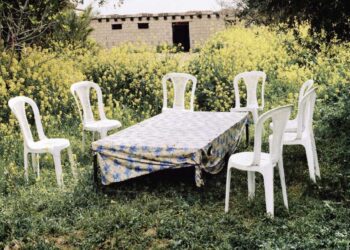Germany is not the most hospitable place for Palestinian stories at present. That’s a fact. Since October 7, the Western European country has embarked on a widespread campaign to silence pro-Palestinian voices whose anti-Zionism stance has routinely and incessantly been framed as antisemitism to shut down any criticism of Israel.
Over the past six months, the discourse on Gaza and the decades-old conflict between Israel and Palestine has been manipulated, oversimplified, and soiled as the mainstream media and politicians joined forces to mobilize its populace to side with Israel and turn a blind eye on the crimes and human right violations the Zionist state has committed before and after October 7.
The ferocious institutional backlash against the pro-Palestine statements at February’s Berlin Film Fest and the continuous prosecution of academics such as the Jewish American philosophy professor Nancy Fraser illustrate that the current German political establishment has no desire of changing course towards Israel in spite of the change in public opinion.
With a growing number of Arab and Palestinian art workers leaving Germany in search of a freer landscape, the extensive Palestinian retrospective of the Arab Film Festival Berlin (aka Alfilm) couldn’t be more urgent or timely: a diverse, multidimensional program exploring different facets of a post-Six Day War Palestinian history as well the evolution of the Palestinian narrative in cinema.
Comprising documentaries, narrative features, and shorts, the program includes works made by Palestinian filmmakers, Arab directors, and European masters, providing a wide array of voices, perspectives, aesthetics, and temperaments.
The oldest title of the lineup is “The Dupes” (1972), the recently rediscovered masterwork by maverick Egyptian filmmaker Tewfik Saleh which was produced by the Syrian Film Organization. The state-sponsored film institute – the most prominent, most affluent Arab film body at the time – was backed by the Ba’ath Party to generate a roster of films promoting the Palestinian cause for reasons later unveiled as the Syrian role in the Lebanese Civil War became clear.
“The Dupes” is the crowning achievement of the Syrian Film Organization’s productions; an adaptation of the assassinated writer Ghassan Kanafani’s 1963 novella “Men in the Sun” about the plight of three Palestinian refugees who embark on a treacherous journey to seek a new, more prosperous existence in Kuwait.
A stark, deeply nihilistic portrait of ordinary Palestinian lives crushed by colossal historical events they never chose to be part of, “The Dupes,” most importantly, was the first picture to pinpoint to the Arab complicity in the Palestinian suffering – a complicity that continues to strongly reverberate in today’s morally muddled geopolitical landscape.
Another film by an Egyptian filmmaker that also underlines the Arabs’ disgraceful position towards Palestine is Yousry Nasrallah’s two-part epic “Gate of the Sun” (2004), a realist fable charting Palestinian history from the eve of the Nakba in 1948 till the late ‘90s.
Framed as a Gabriel García Márquez-like fairytale, “Gate of the Sun” is a love story of sorts: a grand romance of a woman and a man separated by time, fate, and the convoluted relation to a disappearing home. A multitude of characters and viewpoints are relayed in an expansive narrative populated by ghosts of the pasts and ghosts of the present; a sobering tale where the hyperreal and the fantastical are seamlessly intertwined.
Part one, titled “The Departure,” chronicles the aftermath of the Nakba: the loss of the land, the forced displacement, and the initial feverish determination for resistance. Part two, titled “The Return,” depicts the Palestine of the camps and how Arabs turned their back to Palestine.
Each part is different in temperament and political intention: the first laced with the hopeful and stubborn charge of defiance; the second with the pessimism and decadence of post-Sabra and Shatila.
Together, the two parts form a unique and unflinching retelling of the Palestinian narrative while raising a number of thorny interrogations regarding the validation of armed resistance, the deliberately deformed history, and the receding collective memory.
The camp experience is the primary subject of two distinctly dissimilar films. The first is Mats Grorud’s “The Tower” (2018), a warmly-rendered Norwegian animation that chronicles the stories of three generations of Palestinian inhabiting the Lebanese refugee camp of Borj el-Barajneh.
The second is Mohammed Malas’ short documentary, “The Dream,” a heartfelt, poetic look at the modest dreams of the disenfranchised Palestinian dwellers of the Lebanese camps, shot in 1981, a year before the shattering Sabra and Shatila massacre.
The portrait the veteran Syrian filmmaker paints is laced with an innocence, a faint hopefulness, that would soon dissolve and be overtaken by skepticism and bitterness. Echoes of the disillusionment with the Arab leadership can be traced in this deeply compassionate, unsentimental portrayal of a people whose fates remain unknown.
Equally fascinating as a time capsule is the late Lebanese Jocelyne Saab’s short newsreel “The Ship of Exile” (1982), a snapshot of the then PLO leader Yasser Arafat as he departs his temporary Lebanon hiding for a new Greek exile. Highly expressive in the belief in his people’s tenacity and resilience, the always beaming Arafat comes off as a congenial, sharp figure struggling to conceal a weariness, an uncertainty, that seeps through in the brief revealing scenes when he’s not speaking directly to the camera.
The hope that Arafat represented would diminish with the new century and the worsening conditions in both Gaza and the West Bank. Italian documentary filmmaker Stefano Savona retells with chilling detachment the largely forgotten Zeitoun killings where 48 farmers, most of whom were women and children, were murdered by the IDF in the three-week 2008–09 Gaza War.
The Gaza Savona depicts is an abandoned world that has been transformed into a playing field for the IDF to exercise their lustful control. In Gaza, justice is unattainable, and the dream of a free Palestine is nothing more but a pipe dream.
Less bleak if more cynical is Elia Suleiman’s “It Must Be Heaven” (2019). The last satire by Palestine’s greatest filmmaker sees him abandoning his stagnant hometown of Nazareth and venturing into Paris and New York in search for a new home.
Apart from 2002’s “Divine Intervention”, Suleiman’s Palestine has always been an inactive place where change is unforeseeable; a place that has been in arrested development for decades. Suleiman sees Palestine in everywhere he travels: the inner confinement entrenched in the psyche by his homeland never leaves him. His estrangement always leads him back to Palestine, physically and figuratively, like a moth to a flame. The curse of being Palestinian, Suleiman suggests, is that the inherited pain of displacement – from the motherland, from the new adopted home, and from oneself – is unhealable.
The two richest and most complex works of the program originate from unlikely sources.
The first is “Hanna K.” (1983), a mega production directed by French-Greek Oscar winner Costa-Gavras and starring two-time Oscar nominee Jill Clayburgh, acclaimed Irish thespian Gabriel Byrne, and the renowned Palestinian actor Mohammad Bakri in his breakthrough performance.
Clayburgh is the eponymous Jewish American lawyer and child of a Holocaust survivor tasked to defend an enigmatic Palestinian man named Selim (a steely-eyed Bakri) who has been accused of terrorism for illegally entering Israel to reclaim his family’s stolen home.
Although undeniably melodramatic and narratively uneven in parts, “Hanna K.” is nowhere as didactic as the reviews of the time rendered it to be. On the contrary, Costa-Gavras unsung gem leaves an ample space for the viewers to question Selim’s reticent actions and methods while holding a mirror for them to confront their prejudices and unbending views on an unreliable history.
Selim is a cypher: a man with an unknown identity whose experience of growing up in the camps left him with nothing to lose. However questionable his methods may be, Selim remains a broken man with an amputated existence: a man whose entire raison d’être is connected to the home he cannot regain.
In a lengthy review of the film published at the Village Voice in 1983, Edward Said, the most influential Palestinian thinker of the 20th Century, writes: “Yet all of these things are subordinated by Costa-Gavras not only to the frequently unacknowledged human encounters that occur in “The Holy Land,” but also to the moral dilemma of what it means for one people to deny the equality of another on a land where even though they both have national claims, only one people has actually realized them.”
The jewel of the Alfilm’s Palestinian strand is Jean-Luc Godard and Anne-Marie Miéville’s searing 1976 essay film, “Here and Elsewhere.” Originally titled “Until Victory,” the film was commissioned by the Arab League in 1970 in an effort to promote the Palestinian cause. The project – which was co-directed by Godard’s frequent collaborator Jean-Pierre Gorin – was subsequently halted due to the Munich massacre. Miéville, Godard’s last partner, forced a rethinking of the film, editing it from scratch to ultimately produce one of the most engrossing philosophical probes of the Palestinian question and the liberation movements of the ‘60ss and ‘70s.
Godard and Miéville juxtapose footage of the Palestinian armed factions shot in Jordan and Lebanon with fictional scenes of a French family following the news on TV from the comfort of their home as well as staged recordings of Arabs reciting propagandistic speeches.
A meditation on the image’s elusive truth, the unscrupulous mechanisms of image-making, and the soothing apathy TV entraps the European middle-class in, “Here and Elsewhere,” most provokingly, interrogates how the Palestinian narrative has been framed, shaped, and mythologized, dismantling the truth, whatever that may be, we have long held of Palestine.
Alfilm’s Palestinian program provides fragments of a grander picture, Godard postulates, we may have no access to…a picture we can never verify. There’s only one constant truth in the long history of the Palestinian narrative: the striving of a people to have their freedom. Everything else – the righteousness of armed resistance, the veracity of biblical tall tales and historical claims, the legitimacy of the foundation of the Israeli state on the Palestinian land, the weaponization of the Palestinian cause by Arab regimes in suppressing democracy – is debatable and unverifiable.
The moral duty of the viewer is to question and debate what they see because when the probing stops, grave injustice and fascism will take over. This is the central discourse of “Here and Elsewhere,” a film that feels more increasingly about the here than the elsewhere.








